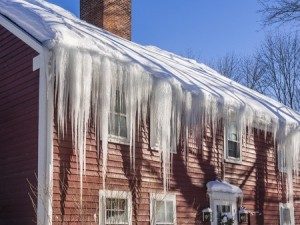 When you have snow on your roof, it should melt gradually and drain into your gutters. If you have ice dams, though, melted snow isn’t able to drain properly. Ice dams form when parts of your roof near the top are warmer than the rest, causing snow in those areas to melt faster. Melted snow then runs down toward the eaves, which are colder, where it freezes and forms blockages called ice dams. These dams block additional melted snow from being able to drain into your gutters, causing it to flow under the eaves and potentially damage your home’s interior. Fortunately, you can take the following steps to prevent ice dams from forming.
When you have snow on your roof, it should melt gradually and drain into your gutters. If you have ice dams, though, melted snow isn’t able to drain properly. Ice dams form when parts of your roof near the top are warmer than the rest, causing snow in those areas to melt faster. Melted snow then runs down toward the eaves, which are colder, where it freezes and forms blockages called ice dams. These dams block additional melted snow from being able to drain into your gutters, causing it to flow under the eaves and potentially damage your home’s interior. Fortunately, you can take the following steps to prevent ice dams from forming.
Keep Snow Off Your Roof
After heavy snowfalls, clear off snow from your roof as soon as it’s safe to do so. Consider using a roof rake to clear away a few feet of snow from around the eaves without having to go up on your roof.
Keep Downspouts Clear
Clear snow and ice away from your downspouts throughout winter. This helps ensure that melted snow can drain from your roof to the ground through your gutters. It also stops you from having pools of standing water around your downspouts.
Add Attic Insulation
Insulation helps keep heated air from reaching your roof through your attic, which lowers the risk of having ice dams form. Make sure your attic has enough insulation, especially in places where heat can sneak through, such as around vent pipes and light fixtures.
Set Up Heated Cables
Heated cables placed around the edges of your roof can help prevent ice dams. These cables, which attach to your roof with clips, give off heat that helps ensure that melted snow from higher up has a clear path to your gutters.
Improve Roof Ventilation
Making sure your roof is adequately ventilated helps cooler air circulate below the whole roof surface. This prevents certain areas from becoming warmer than the rest, which reduces your risk of ice dams. Ideally, you should have a ridge vent and soffit vents that have openings of the same size.
If you end up with damage caused by ice dams, check your homeowners’ insurance policy. Depending on your policy, you might be covered for issues such as water damage, mold growth, damaged siding or shingles and damaged insulation.
Before having damages to your home repaired due to ice dams or any other circumstance, contact Waite’s Insurance Agency to find out if your current policy covers such repairs.
